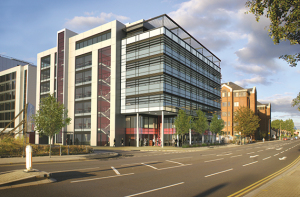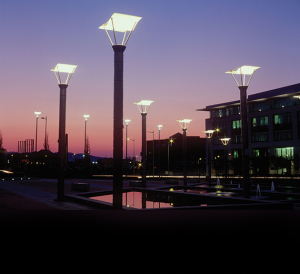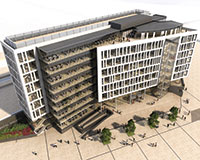 Did you hear the enormous roar coming from Cardiff on 22 September? No, nothing to do with the Rugby World Cup. The mighty cheer was from property folk, and the team basking in the crowd’s approval was Legal & General, the BBC and local developer Rightacres.
Did you hear the enormous roar coming from Cardiff on 22 September? No, nothing to do with the Rugby World Cup. The mighty cheer was from property folk, and the team basking in the crowd’s approval was Legal & General, the BBC and local developer Rightacres.
Legal & General’s £400m backing for the 150,000 sq ft BBC offices at Rightacres’ Central Square, and further phases of backing for the entire 1m sq ft development, promises to seal the transformation of Cardiff from limping provincial office market to potentially glitzy metropolitan hub.
The deal opens the door to the £80m BBC offices, as well as office development at the already-under-construction 135,000 sq ft block at 1 Central Square, 150,000 sq ft at 2 Central Square, (above) and a new 400,000 sq ft transport interchange.
While Cardiff’s property folk are digesting the implications for the city’s private sector-led future, so public sector involvement in the Welsh capital’s office market is being unwound.
The Welsh government’s 2013 decision to move into the commercial office market was hugely controversial. Its autumn 2015 decision to pull out looks like being just as fraught.
 A sudden uptick in demand for city office space, and much-improved appetite for private-sector speculative office development, provides the background for the u-turn. The modest controversy hinges on three prime office sites leaving the Welsh public sector, all of them in the vicinity of Callaghan Square (pictured).
A sudden uptick in demand for city office space, and much-improved appetite for private-sector speculative office development, provides the background for the u-turn. The modest controversy hinges on three prime office sites leaving the Welsh public sector, all of them in the vicinity of Callaghan Square (pictured).
The headliner is the disposal of the 4.5-acre development site acquired in 2013 from MEPC for £7.2m plus various associated costs. The idea was that the government would back speculative development at this key location, opening the door to inward investment and giving the property market a useful kick-start (or kick in the teeth, according to those who thought the intervention would undermine rental growth).
In August, under pressure to cut costs and after a potential prelet to Deloitte evaporated, the government announced the site would be sold. What happens next is unclear. An obvious office site, say some, it is now being touted as a potential location for either a 13,000-seat indoor arena, mixed-use development including offices, or student housing.
Paul McCarthy, chief executive at Rightacres, is hoping for something mixed. McCarthy chooses his words carefully when describing past and future Welsh government intervention at the site. “It’s always been contentious,” he says. “This site might be valuable for student housing, or the private rented sector, and it may not go forward for the use originally intended.”
Rightacres’ Central Square scheme will mop up much of the office demand, he insists. In these circumstances, offices on the vacant lot at Callaghan Square would be superfluous.
Gary Carver, director at Savills, agrees – up to a point. “If we get 800,000 sq ft built at Central Square, and another 200,000 sq ft at Capital Quarter, some might argue that’s enough city centre office space. On the other hand, there could easily be requirements that take that space fairly quickly, so I can see the site as mixed-use – some office, some PRS. And an arena is more likely not at the Callaghan Square site, but at the Brains Brewery site.”
Observers like Rhys James, senior director at Cushman & Wakefield, thinks that if the Welsh government tries to recoup its purchase price, then the relatively high land price could determine the outcome.
“That’s a big input cost. Whoever takes on the site will have to be of substance. And I wouldn’t expect the government to sell to someone who will sit on the site and leave it undeveloped,” he says.
Tom Merrifield, head of agency at Bilfinger GVA in Cardiff, adds: “You’ll need an adventurous and gutsy developer to bring it forward, but it could expect good results if it does. Developers like JR Smart have made a living out of doing just that,” he says.
The consensus is that the government is right to pull out. Rhydian Morris, director at JLL, says: “Developers like JR Smart and Rightacres can develop speculatively on their own. Public sector intervention is not required.”
Exactly how the site will be sold, when, and at what price remains unclear. Those with a track record of advising the government say officials are looking at recommendations. The market believes the decision will be an open-market sale at a price, say, a shade over £20m, a yield a shade under 6.5%.
A Welsh government spokesman told EG: “We are considering options for the marketing and disposal of the site in ways that will deliver development and respond to known market interest. All options are under consideration and a decision on the preferred way forward will be made shortly.”
The sale comes soon after the public sector disposed of the two-acre John Street site, which bridges Callaghan Square and JR Smart’s Capital Quarter. JR Smart bought the sight and planning will be resolved next year, for a start on site in early 2017. A scheme of up to 240,000 sq ft could be in view.
It’s a sign of how touchy the Cardiff market has become that JR Smart’s acquisition caused a minor frisson. As it happens, it’s a simple story of commercial acumen: well-placed sources say JR Smart acquired the key slice of the site owned by Welsh National Opera, without which the rest is undeliverable. The firm then approached the other three landowners including the Welsh government and Cardiff council. No surprise a sale was agreed.
A Welsh government spokesman would say only that there had been no formal tendering, and that the sale was ultimately by private treaty.
A freshly invigorated private sector looks like setting the pace well into 2017. Meanwhile, the public sector is preparing to confine itself to smaller-scale interventions.
Ken Poole, head of economic development at Cardiff city council, points to the £400m intervention by Legal & General, and says: “The public sector’s role in stimulating investment will change as the private sector continues to review investment opportunities in the city favourably.”
“The public sector role is likely to be focused on specific projects with the private sector that would not be viable and where a partnership approach with the public sector particularly involving their land could be introduced.”
Redeveloping the 140,000 sq ft Coal Exchange for media and tech occupiers could be the next outing for the new spirit of partnership and co-operation. The Legal & General move could transform Cardiff’s office market – but it will mean a shift in the balance of power. How the public sector – and the private sector – respond to the new circumstances with become clear as 2016 unfolds.
For sale – Three Welsh Assembly government sites
• A 4.5 acre slice of Callaghan Square development site bought from MEPC in 2013 for about £8m, which now has planning permission for a 90,000 sq ft block
• The nearby 75,000 sq ft 1 Capital Square building, part of local developer JR Smart’s Capital Square regeneration project, was acquired by the government for £15m for its own occupation
• Two acres at John Street between Callaghan Square and Capital Quarter, acquired by JR Smart. Vendors include the Welsh government, the city council, Welsh National Opera and a private landlord.
Demand is up, so when will rents go up?
A market with, it is said, 750,000 sq ft of active office requirements in play during 2015, but just 350,000 sq ft of them satisfied so far, is one in which rents ought to be rising and speculative development steaming like a kettle.
Rents, long becalmed at £21-£22 per sq ft – are at last moving towards £24-£25 per sq ft, the point at which marginal viability appraisals turn into appealing prospects. Indeed, according to Rightacres chief executive Paul McCarthy, they have already reached £25 per sq ft. “We’re getting £23-£25 per sq ft now, with £25 on a prelet of 3,500 sq ft, a ten-year lease with six months’ rent free,” he says.
Rhys James, senior director at Cushman & Wakefield, says: “We’ve got a 10,000 sq ft floor at 1 Central Square on terms of £24 per sq ft, so things are edging up. Within 12 months we’ll see £25 per sq ft, and that will potentially bring new developers into Cardiff.”
New arrivals are already appearing. The Ardstone Regional Office Fund has acquired 2 Kingsway for refurbishment, and is adding extra floorspace to take the total to 40,000 sq ft. Tom Merrifield, head of agency at letting agents Bilfinger GVA, says the quoting rent will be £22.50. “It’s not unrealistic.” The scheme will be ready in spring 2016.
Speculative office development – as opposed to refurbishment – is widely expected to gather pace. Rightacres has two potential prelets totalling about 40,000 sq ft that will kick start about 120,000 sq ft of speculative floorspace at Central Square. Quoting rents, prepared with a late 2017 completion of building works, will match or exceed the £25 per sq ft agreed on the prelets, says McCarthy.
At Capital Quarter, JR Smart is rumoured to have two 70,000 sq ft speculative schemes ready to roll, once the 85,000 sq ft 2 Capital Quarter is complete.
Says Owen Young, partner at Alder King: “It’s a market on the cusp. We’ve got 50,000-70,000 sq ft of call centre requirements, a string of public sector requirements that could add up to 250,000 sq ft, another 80,000 sq ft of professional requirements. I’d expect prelets in the first quarter of 2016 to take headline rents on, and narrow the gap with net effective rents.”
Rhydian Morris at JLL recoils at the suggestions of 400,000-500,000 sq ft of live requirements – “a bit steamy” he says – but agrees demand is bountiful. If long-standing requirements are revived, such as Legal & General’s on-off hunt for around 120,000 sq ft, those steamy figures could look icily reasonable.











